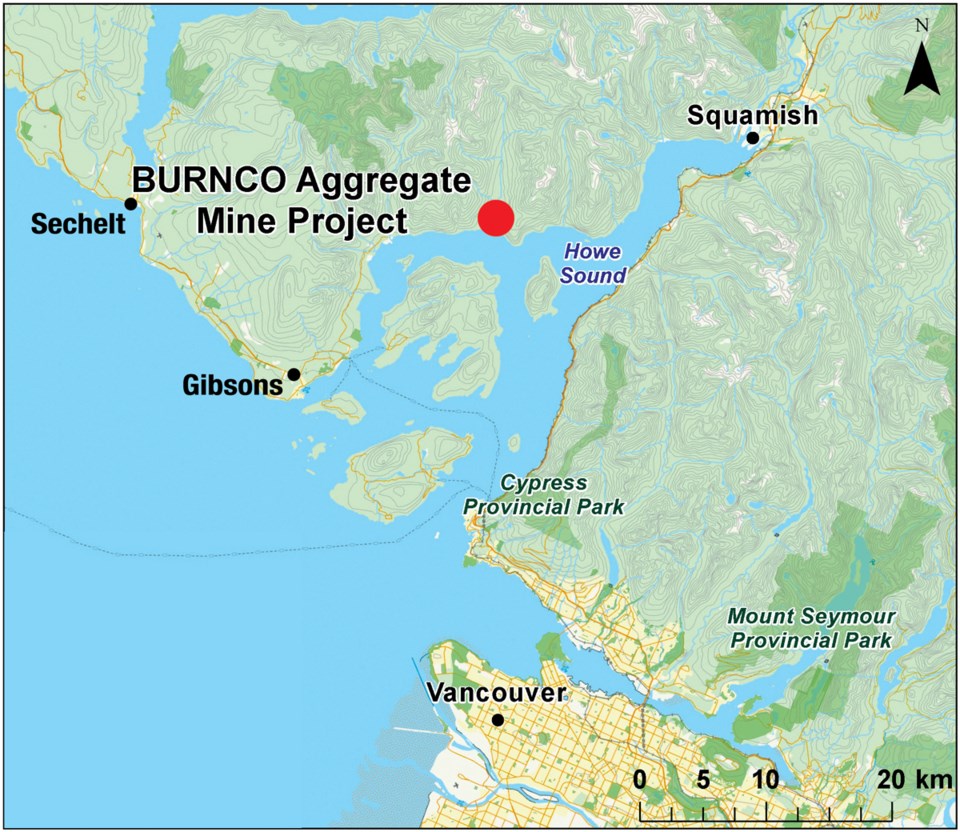Following a decision made by Environment Minister George Heyman and Energy Minister Michelle Mungall, Burnco Rock Products Ltd. has been issued an environmental assessment certificate by the Ministry of Environment and Climate Change Strategy for its proposed aggregate mine at McNab Creek.
“Having considered the Environmental Assessment Office’s (EAO) Assessment Report and the recommendation of the executive director of the EAO to issue a certificate, the ministers are confident that the project will be constructed, operated and closed in a way that ensures that no significant adverse effects are likely to occur,” stated a press release from the EAO, issued Tuesday.
The process required Burnco to satisfy 25 conditions and the project had to meet certain design requirements, all of which are legally binding.
In late February, Skwxwú7mesh (Squamish) Nation indicated its support for the project, after “having reached an agreement with Burnco in order to mitigate its concerns,” said the press release. That agreement is legally binding, and requires Burnco to adhere to conditions aligned with the Squamish Nation’s environmental management plans. The First Nation also conducted a third-party assessment of the project.
“Squamish Nation along with the many other stakeholders were instrumental in the decision,” wrote Derek Holmes, land and resource manager with Burnco, in an email.
The EAO also consulted with Squamish Nation, Tsleil-Waututh Nation and Musqueam Indian Band.
Key provincial conditions require Burnco to:
• Develop a marine mammal protection plan during construction to address underwater noise.
• Develop a fish habitat protection and management plan and a wildlife protection plan to assess, monitor and address impacts to wildlife throughout the life of the project.
• Develop a water management plan to monitor and manage impacts from the mine to nearby watersheds and groundwater flow.
• Develop an air quality and dust control plan to manage fugitive dust emissions.
• Specify measures that will minimize the visibility of the mine from neighbouring properties.
Burnco has also changed design elements of its project as a result of public and stakeholder feedback, including:
• Increasing the amount of fish habitat offset and greater management of surface and groundwater flow.
• Revising size, location and design of the pit lake containment berm and McNab Creek flood protection dike.
• Reducing proposed maximum depth of the pit lake.
• Reducing proposed duration and frequency of aggregate barge loading and movements, and proposed hours of construction and operations activities.
Ian Winn, Sunshine Coast Regional District (SCRD) director for West Howe Sound, has been a vocal critic of the process and said he was “deeply disappointed” by the province’s decision.
“The processes used to make this decision are flawed to the point where the BC Environmental Assessment Office has initiated a revitalization of the Environmental Assessment process in order to ensure that the public’s expectation of a strong transparent process is met for future proposals,” Winn said in an email.
At an SCRD meeting, he said out of hundreds of people who have contacted him, “probably less than 10” want the project to go forward.
Ruth Simons, executive director of Future of Howe Sound Society, expressed “extreme disappointment” following the announcement.
“I think the environmental assessment people know there are still gaps,” Simons said. “You can have open houses, you can have public comment, but the loop back to the people – we’re just stuck in consultation that is not meaningful.”
Simons criticized the process at an SCRD meeting in December, citing the lack of a comprehensive land use plan for the affected Howe Sound area and no official community plan for the area north of Port Mellon as two major concerns. She also disagreed with the conclusions that the project will have no significant adverse effects. “That’s been our complaint from the very beginning, that Howe Sound doesn’t have a comprehensive plan and it had huge value over and above the use of it as a gravel mine.”
Winn also said it was “disturbing” that the EAO did not wait until the Ministry of Forests, Lands, Natural Resource Operations and Rural Development completed its Cumulative Effects Assessment for Howe Sound before giving its approval.
If approved, the gravel, sand and rock mine will be located on Squamish Nation territory, on the northwest shore of Howe Sound, and could extract up to 1.5 million tonnes of aggregate per year over its 16-year lifespan, with shipments barged across the sound.
The construction phase of the project is expected to create 80 full-time jobs over a two-year period, and 14 full-time jobs could be created during the operations phase.
The Canadian Environmental Assessment Agency is also conducting a review, and a federal decision will be provided upon completion.
Holmes said he expects the federal decision to be made in the next few weeks.
If the project is granted approval at both the federal and provincial levels, the SCRD will need to approve a rezoning application to allow the project to conduct certain types of processing at the site.
Despite the ongoing criticism, Holmes remains optimistic about the project’s future. “Aggregate is in constant demand and all producers know that their existing operations won’t last forever. When the time comes to permit the next one, your past performance will determine your success and we intend to be here for the long haul.”



